2022 Volume 7 Article ID: 20220038
2022 Volume 7 Article ID: 20220038
Objectives: In Japan, there is no established method to assess the ability to read and write in English. To address this problem, we sought to develop a screening test for the early detection of students who show difficulties in reading and writing in English.
Methods: The participants were 425 fifth- and sixth-grade elementary school students and 526 first- through third-grade junior high school students. While setting up the task items, we focused on the assessment of visual information processing ability related to letter-symbol information processing. Q1 was a letter identification task, Q2 was a letter recognition task, Q3 was a discrimination task, Q4 was a lexical decision task, Q5 was a semantic comprehension task, Q6 was a meaningful sentence copy task, and Q7 was a nonsensical sentence copy task. Q1 to Q5 assessed reading ability and Q6 and Q7 assessed writing ability.
Results: The comparison of basic distribution between elementary and junior high school showed that there were differences in the distribution of both reading and writing scores between the two school types (P<0.05). At the cut-off value of −1.5 SD, 7.8% of the students were extracted for reading scores and 4.2%–5.5% for writing scores.
Conclusions: The extraction rate of students using this screening test supports the results of previously published studies. Thus, this screening test is considered suitable for identifying elementary and junior high school students who face difficulties in reading and writing in English.
Reading and writing difficulties are classified as specific learning disorders in the Diagnostic and Statistical Manual of Mental Disorders, 5th edition (DSM-5).1) The diagnostic criteria for reading difficulties include reading inaccuracy, nonfluency, and difficulty in reading comprehension. Writing difficulties include spelling, grammar, punctuation inaccuracy, and organization of written expression for writing difficulties. Reading difficulties are diagnosed as dyslexia when reading achievement is 1.5 SD below the grade-level equivalent and is seen in about 7% of the population.2,3,4) In recent years, the incidence of dyslexia has been reported to range from 4% to 20%.5) The incidence of writing disorders is reported to be 7%–15%.6)
It has been pointed out that reading and writing skills are directly related to native and second-language skills, and that difficulties in language skill acquisition in the native language also indicate weaknesses in second-language acquisition.7) Furthermore, English, which is a major foreign-language subject in Japan, is said to cause more difficulties in reading and writing acquisition than Japanese language because of the complexity of the correspondence between graphemes and phonemes.8) Based on these findings, it can be assumed that children who show weaknesses in reading and writing in Japanese may also show similar difficulties in learning English. Even children who do not show weaknesses in learning Japanese may stumble for the first time when learning English. It is important to predict and manage reading and writing difficulties at an early stage, before they show any delay in learning, to effectively help these children. However, in Japan, screening tests have not yet been established to accurately identify children who show difficulties in reading and writing in English.
With full implementation of the Plan for the Reform of English Language Education in Response to Globalization from the fiscal year 2020, the introduction of English as a subject at the elementary school level and the expansion of English learning content at the secondary school level are being promoted in Japan. In the Japanese educational curriculum, students begin to listen to and speak English from the third grade of elementary school, and English language studies begin in the fifth grade. The target for students is to acquire about 600 to 700 words at the elementary school level and about 1600 to 1800 words at the junior high school level. We are attempting to develop a screening test for the early identification of children with difficulties in reading and writing in English. As a first report, we discuss the issues involved around constructing a screening test. We also report the basic distribution of indicators based on the results of a preliminary survey and discuss the calculations to examine if there is a risk cut-off value and extraction rate that may be used for such screening tools.
The survey was conducted at eight public elementary and junior high schools in Kochi Prefecture (five elementary schools and three junior high schools), where the Board of Education and the school principals agreed to cooperate in the survey. In each school, the survey targets were fifth graders in elementary schools to third graders in junior high schools enrolled in regular classes. We had a total of 951 survey participants, consisting of 425 elementary school students and 526 junior high school students. The socio-economic status of each student was not investigated in this study. The surveyed schools were aligned with the general English education system in Japan.
Compositional TasksIt is critical to clarify the process of linguistic information processing that Japanese students go through when reading and writing in English and to identify the instances where they face challenges. In English-speaking countries, phonological processing is the most widely known factor behind dyslexia; however, in Japan, where the language system is different from that of English-speaking countries, morphological processing has also been highlighted.9,10) In the present study, we relied on a cognitive neuropsychological model and structured the tasks around assessment of visual information processing abilities related to reading and writing that could be conducted in groups.11)
The tasks were designed using the Psycholinguistic Assessments of Language Processing in Aphasia (PALPA),12) the Woodcock Reading Mastery Tests 3rd Edition (WRMT-III),13) and the Gray Diagnostic Reading Tests 2nd Edition (GDRT-2),14) which are widely used in English-speaking countries. Additionally, based on the results of the Research on English Education in Elementary Schools (National Institute for Japanese Language Education Policy, 2008),15) the required basic words in textbooks used by students whose native language is Japanese were used. Figure 1 shows the task contents, examples, and evaluation items.
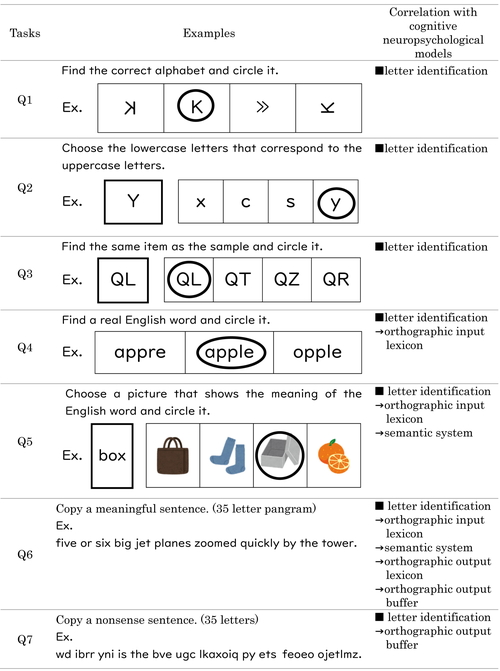
Screening test contents.
Q1. Letter identification task (upper case): 10 questions. A choice of the correct letter from a group of symbols. While focusing on the letters used in PALPA’s Mirror Reversal task, we used uppercase letters that elementary school students are likely to make mistakes in identifying, as reported in the National Institute for Educational Policy Research’s “Research on English Education in Elementary Schools.” Time limit 1 minute.
Q2. Letter recognition task (lower case): 10 questions. This was a selection task to choose the uppercase letter of a sample stimulus and the corresponding lowercase letter. The alphabet from PALPA’s Letter Matching task was used to assess letter identification and letter knowledge. Time limit 1 minute.
Q3. Discrimination task: 10 questions. This was a selection task to identify and choose a given alphabet string from a group of non-real words. We used the words used in PALPA’s Visual Lexical Decision task, letters in words and non-words tasks, and WRMT-III’s Word Attack task to assess morphological awareness and visual short-term memory. Time limit 2 minutes.
Q4. Lexical decision task: 10 questions. A selection task to find and select real words from a group of stimuli containing both real and non-real words. This task assessed the ability of students to use lexicons and lexical judgment. Only English words learned in English textbooks at elementary school were used. There were four options: (1) the real word, (2) a word phonetically similar to the real word, (3) similar spelling to the real word, and (4) one letter replaced by another. Time limit 2 minutes.
Q5. Semantic comprehension task: 10 questions. For each English word presented, students were asked to choose an illustration that indicated the correct meaning. Students were assessed on their semantic knowledge and other abilities. Only English words learned in English textbooks at elementary school were used. There were four options: (1) the correct illustration corresponding to the sample word, (2) an illustration showing the meaning of a word that is phonetically similar to the sample word, (3) an illustration showing a word that is semantically related to the sample word, or (4) an unrelated illustration. Time limit 2 minutes.
Q6. Visual copying task (meaningful sentences): A writing task in which participants had to quickly and accurately copy the presented meaningful sentences repeatedly within the time limit. A 35-letter pangram (a sentence using all 26 letters of the alphabet) was used for this task. Time limit 2 minutes.
Q7. Visual copying task (nonsensical sentences): A writing task to quickly and accurately transcribe the presented nonsensical sentences. A 35-character nonsensical sentence, which was reconstructed by decomposing the pangram used in Q6, was used as the task sentence to be copied repeatedly within the time limit. These two tasks (Q6 and Q7) assessed the cooperation between vision, movement, and the ability to pay attention and concentrate. Time limit 2 minutes.
ProceduresThe survey was conducted between December 2020 and February 2021. It was conducted by classroom teachers or subject teachers in each elementary and junior high school in a group format in a classroom environment. The survey forms were A4-size booklets, one for each student. The teacher read out the instructions according to the implementation guide distributed in advance and proceeded with the tasks. The time required from distribution to collection of the survey forms was approximately 20 minutes.
AnalysisQ1 to Q5 mainly assessed basic reading skills, while Q6 and Q7 mainly assessed basic writing skills. For Q1 to Q5, the number of correct answers was scored (10 points each), and the total of these was considered the “reading score” (50 points). For Q6 and Q7, the average number of letters per minute was calculated from the number of letters that could be transcribed correctly within the time limit, and the average was then further averaged and considered the “writing score.” The Mann–Whitney U test was used to compare scores between elementary and junior high schools, and Spearman’s correlation analysis was used for correlations between items. Furthermore, the Wilcoxon signed rank test was used to compare scores between Q6 and Q7, and Spearman’s correlation analysis was used to correlate Q6 and Q7. For the cut-off values, several standard deviations and percentile values were used in the analysis to find more appropriate values for English learners whose native language was Japanese. The seven criteria were −1 SD, −1.5 SD, −2 SD, 5th percentile, 7th percentile, 10th percentile, and 15th percentile. All analyses were conducted using IBM SPSS Statistics ver. 26, and the level of statistical significance was at P<0.05.
Ethical ConsiderationsThis study was conducted with the approval of the Research Ethics Review Committee, School of Allied Health Sciences, Kitasato University (No. 2020–004). We obtained written informed consent from the schools’ principals and teachers after explaining the scope of the survey. Prior to conducting the study, an explanatory document was distributed to parents. If they did not wish to participate in the study, they were asked to notify us, and the participation of the children in question was canceled accordingly. The document clearly stated that each student’s school record would not be affected in any way regardless of participation in the study. The teacher in-charge explained the intention of the survey to the target students and informed them that their response to the survey would be regarded as consent and that there would be no disadvantage if they did not participate.
The descriptive statistics of the scores of elementary school children are shown in Table 1. The basic distribution of the reading scores is shown in Fig. 2 and that of the writing scores is shown in Fig. 3 The scores for Q7 were significantly higher than those for Q6 (Z=6.13, P<0.05). In addition, there was a strong correlation between Q6 and Q7 (ρ=0.838, P<0.05).
| Q1 | Q2 | Q3 | Q4 | Q5 | Q6 | Q7 | Reading score | Writing score | |
| Mean | 9.7 | 9 | 9.1 | 4.8 | 6.6 | 82.2 | 86.4 | 39.2 | 42.2 |
| SD | 0.8 | 1.5 | 1.1 | 2.3 | 2.5 | 32.9 | 29.5 | 5.7 | 14.9 |
| Median | 10 | 10 | 9 | 5 | 7 | 78 | 86 | 40 | 40.5 |
| Range | 0–10 | 0–10 | 3–10 | 0–10 | 0–10 | 3–280 | 0–191 | 17–50 | 0.8–113.8 |
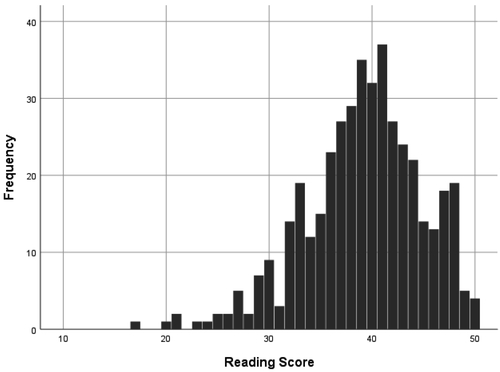
Reading score frequency histogram for elementary school students.
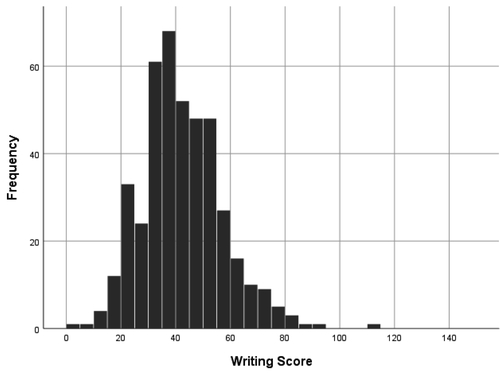
Writing score frequency histogram for elementary school students.
The descriptive statistics of the scores of junior high school students are shown in Table 2. The basic distribution of the reading scores is shown in Fig. 4 and that of the writing scores is shown in Fig. 5 The Q6 score was significantly higher than the Q7 score (Z=−16.09, P<0.05). In addition, there was a strong correlation between Q6 and Q7 (ρ=0.746, P<0.05).
| Q1 | Q2 | Q3 | Q4 | Q5 | Q6 | Q7 | Reading score | Writing score | |
| Mean | 9.9 | 9.9 | 9.5 | 8.5 | 9.1 | 164.2 | 139.4 | 46.9 | 75.9 |
| SD | 0.7 | 0.6 | 0.8 | 1.9 | 1.2 | 45.3 | 36.2 | 3.4 | 19.2 |
| Median | 10 | 10 | 10 | 9 | 9 | 165 | 140 | 48 | 76 |
| Range | 0–10 | 1–10 | 6–10 | 0–10 | 2–10 | 0–315 | 0–249 | 29–50 | 0–132.3 |
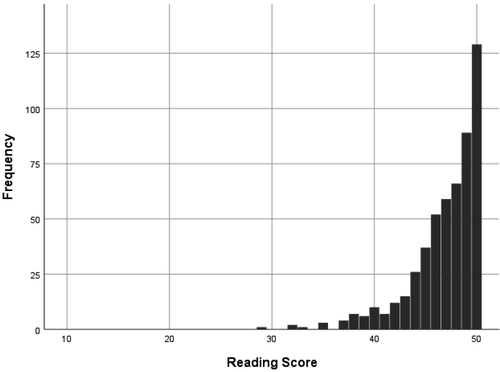
Reading score frequency histogram for junior high school students.
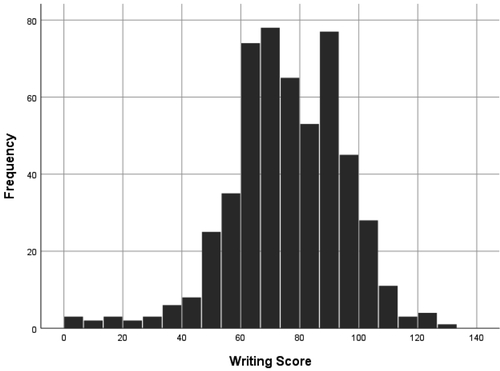
Writing score frequency histogram for junior high school students.
When the basic distributions were compared between elementary and junior high schools, significant differences in distributions were observed between the school types for both reading and writing scores, with higher scores in junior high schools than in elementary schools (Z=20.69, P<0.05; Z=22.25, P<0.05; respectively). Therefore, it was decided to set a cut-off value for each school type. Table 3 shows the candidate cut-off values for elementary schools and the percentage of children identified, and Table 4 shows the candidate cut-off values for junior high schools and the percentage of students identified, calculated based on the set criteria.
| Criteria | Q1 to Q5 Reading score | Q6 and Q7 Writing score | |||
| Cut-off value | Percentage | Cut-off value | Percentage | ||
| −2 SD | 27 | 3.5% | 12 | 1% | |
| −1.5 SD | 30 | 7.8% | 19 | 4.2% | |
| −1 SD | 33 | 16.2% | 27 | 15.1% | |
| 5% | 29 | 5.6% | 20 | 4.5% | |
| 7% | 30 | 7.8% | 21 | 6.6% | |
| 10% | 32 | 11.8% | 23 | 9.2% | |
| 15% | 33 | 16.2% | 27 | 15.1% | |
| Criteria | Q1 to Q5 Reading score | Q6 and Q7 Writing score | |||
| Cut-off value | Percentage | Cut-off value | Percentage | ||
| −2 SD | 40 | 6.5% | 37 | 2.9% | |
| −1.5 SD | 41 | 7.8% | 47 | 5.5% | |
| −1 SD | 44 | 17.9% | 56 | 12% | |
| 5% | 40 | 6.5% | 45 | 4.8% | |
| 7% | 41 | 7.8% | 49 | 6.8% | |
| 10% | 42 | 10.1% | 53 | 9.3% | |
| 15% | 44 | 17.9% | 59 | 14.8% | |
This study developed a screening test to identify Japanese school students that have difficulty in reading and writing in English. Such an assessment tool has not been previously established in Japan. The study also presented a cut-off value and extraction rate from the test.
The screening test relied on the theory of cognitive neuropsychological models. In the assessment of reading ability, Q1 to Q3 evaluated the ability of letter identification and morphological recognition, Q4 evaluated the understanding of orthographic input lexicon, and Q5 evaluated semantic knowledge. In the assessment of writing ability, Q6 evaluated the ability to write letters through semantic knowledge and Q7 evaluated the ability to write letters without semantic knowledge. In other words, all the items were structured in accordance with the order of the letter-symbol information processing system, from reading to writing.
For the assessment of reading ability, the total score of all five questions (Q1 to Q5) was considered representative score to evaluate the basic ability to read, based on character identification to the meaning system of the cognitive neurological model. The results showed significant differences among school types, with junior high school students scoring higher than elementary school students. This suggests that the basic skills related to reading develop or become more proficient as the grade advances. In particular, there was a large difference in the scores of Q4 and Q5. However, given that these were questions about distinguishing real words from non-real words (Q4) and about the meaning of real words (Q5), it is assumed that proficiency in the orthographic input lexicon and the semantic system stage played a large role in this difference. By analyzing each task in detail, it is possible to evaluate the stage of the reading process at which the students show difficulty.
For the assessment of individuals’ writing ability, the average number of letters written per minute in Q6 and Q7 was calculated as the writing score. Kono et al.16) reported that the results of a Japanese writing task administered to elementary school students showed that the number of written letters was significantly higher for all grades when compared with previous grades (e.g., more for sixth graders than for fifth graders), and that the number of written letters was higher in the meaningful sentence task than in the nonsensical sentence task. In our study, junior high school students also wrote significantly more, suggesting that developmental differences in writing speed also occurred in the English visual copying task. In addition, the scoring patterns differed among school types, with elementary school students scoring higher on the nonsensical sentence task than on the meaningful sentence task. In contrast, junior high school students scored higher on the meaningful sentence task than on the nonsensical sentence task. This could have been caused by their decision to use the semantic system to efficiently memorize and write sentences and words. At the elementary school stage, when the students were not proficient in learning English, both the meaningful and nonsensical sentence tasks went through a nonlexical route that did not involve the semantic system. In addition, the meaningful sentence task was performed first, which may have increased the efficiency of the nonsensical sentence task because of the effect of order. In contrast, in the junior high school stage, where students are more proficient in learning English, the meaningful sentence task was conducted via the lexical route through the semantic system, which may have enabled them to transcribe more efficiently. There was a strong correlation between Q6 and Q7 in both elementary and junior high schools. In the future, we would consider omitting one of the questions and administering only one task.
In this study, seven values were established as candidate cut-off values. Based on these candidate values, 1%–16% of children were identified. We examined which of these values were appropriate as a cut-off value. Dyslexia is diagnosed when reading achievement is 1.5 SD below grade level, which is seen in approximately 7% of the population.2,3,4) In Japanese literacy screening tests, such as the Standardized Test for Assessing the Reading and Writing (Spelling) Attainment of Japanese Children and Adolescents: Accuracy and Fluency (STRAW-R),17) a score that falls 1.5 SD below the grade level is considered a possible abnormality and a score that falls 2 SD below is considered a clearly abnormal value. In the results of the present study, using the 7th percentile as the cut-off value of reading scores identified 7%–8% of the students as the risk group, and the same was true at the reading score cut-off value of −1.5 SD. These extraction rates were consistent with previous studies. In contrast, using the 7th percentile as the cut-off value for writing scores identified 6%–7% of students, whereas −1.5 SD identified 4%–6% of students and was consistent with a previous study.17) Literature values for the incidence of writing disorder are 7%–15%, but using these cut-off values, a lower percentage was obtained. There are several possible reasons for this, and one of them is the difference in the abilities assessed. In general, writing disorder includes spelling, grammar, and punctuation accuracy along with spelling representation and organization skills. The writing task in this study focused on basic visual skills and did not include grammatical or sentence structure skills. It is possible that this was reflected in the results. However, given that it is considered desirable to assess more basic skills for early screening, this selection rate is appropriate at this point. From the above, we believe that it is appropriate to use the 7th percentile or −1.5 SD as a cut-off value for both reading and writing scores.
In this Japanese study, we developed a screening test to identify students who show difficulties in reading and writing in English and presented data on the cut-off values based on the basic distribution. Such a test has not been established to date in Japan. However, this was a preliminary study, and further investigation of the task structure and extraction rate is needed. In addition, this screening test was designed to be an assessment tool that can be implemented as part of a regular class, focusing on the assessment of visual cognitive functions related to letter-symbol information processing (reading and writing). However, given that phonological awareness has also been pointed out to be involved in dyslexia,18) it is necessary to assess phonological awareness and the decoding ability of children to comprehensively understand students who face difficulties in reading and writing. In addition, there are many students who have difficulties in reading and writing in English even if they do not have a special functional background. It is important to clarify the cognitive background of students who face difficulties in reading and writing in English from various perspectives to quickly provide instructions that address the difficulties of each individual student. In the next and subsequent surveys, the target area and target students should be expanded, the reliability of the task should be tested, and the validity of this screening test should be verified. In addition, comparisons should be made not only between school types but also between grades to identify differences in development or proficiency between grades. A careful analysis of cut-off values would also be necessary. We will continue to assess the feasibility of identifying students who truly show difficulties in learning English.
The authors have no conflicts of interest to disclose.